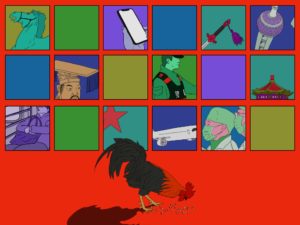‘White people’s food’ evokes laughter, mockery — and praise — on the Chinese internet
'Have they evolved to a point where they can generate energy without eating actual food?'

Raw vegetables. Apple slices and berries. Hummus dip. Cold sandwiches. Crackers with ham and cheese.
In many Western countries, these are healthy snacks or even meals. But they are laughably simple by Chinese tastes, which cherish complex flavors and difficult cooking techniques.
China news, weekly.
Sign up for The China Project’s weekly newsletter, our free roundup of the most important China stories.
This clash of styles has led to a new food trend taking over Chinese social media, in which students and office workers in search of low-effort meals are packing lunch boxes with minimally seasoned and easy-to-prepare items. This cuisine is snarkily called “white people’s food” (白人饭 báirén fàn).
“White people’s food” was initially an object of intrigue and ridicule on the Chinese internet. The term gained traction in the last few months on Chinese lifestyle-sharing app Xiaohongshu when users living in the West posted their bewilderment at the eating habits of the people around them.
“Have they evolved to a point where they can generate energy without eating actual food?” a Xiaohongshu user based in Denmark wrote about a colleague’s lunch. The post included a photo of a few baby carrots and raw spinach leaves in a Tupperware container.
One of the roughly 3,000 comments to the post reads, “Even my pet rabbit wouldn’t settle for these unpeeled carrots.”
In another popular clip bearing the tag “white people’s food,” a Chinese woman in Switzerland filmed a woman putting together her lunch on a train by wrapping pieces of ham in lettuce and pairing it with mustard. “I just saw how far ‘white people’s food’ could go today. The people here never cease to shock me with their eating tricks,” the user wrote.

But as the Chinese diaspora gathered to roast American and European love of underseasoned salads, plain chicken breasts, and mayonnaise, others on the Chinese-language internet praised this so-called “white people’s food.”
The first people to rally to the defense of “white people’s food” were those on diets, who praised the meals’ caloric content and richness of fiber and nutrients. Then there were college students who didn’t have kitchens, who saw the trend as a no-cooking alternative to ordering takeout all the time.
But the group that really embraced it were young professionals in China, who played a critical role in elevating “white people’s food” into a mainstream discussion.
The biggest perk to preparing and bringing lunch made of “white people’s food” to work, they said, is its fuss-free nature. The option is particularly appealing when compared with cooking Chinese dishes, which is too much of a hassle after a long day at work.
“I used to love watching cooking videos and trying out new recipes,” a Xiaohongshu user explained. “But as time went on, I found it increasingly troublesome. As a laborer, I don’t have much free time after work, and all I want to do is look at my phone.”
Others pointed out the nutritional benefits that come with the trend, stressing that “white people’s food” can prevent post-lunch drowsiness at work because unlike Chinese meals — which often contain rice or noodles — raw vegetables and fruits are low on carbs. “There’s this popular saying among older Chinese that to lead a healthy lifestyle, one needs to have a proper breakfast and a fulfilling lunch but eat little for dinner. But I think it actually works better for office workers if the order is reversed. If we eat little for lunch, we won’t feel sleepy in the afternoon,” a person wrote on Xiaohongshu.
“White people’s food” is not for everyone, though. Some proponents of the trend admitted that it requires a special mindset that treats eating as a means of keeping the body alive. It is, sadly, devoid of joy or pleasure. “After I adopted the mentality that I eat in order not to die from starvation, ‘white people’s food’ became appealing to me. I no longer want to throw up when eating the same type of food every day,” a Xiaohongshu user wrote.
This attitude toward cooking and dining seems to be a continuation of the “lying flat” (躺平 tǎngpíng) and “let it rot” (摆烂 bǎilàn) movements that have taken root in Chinese youth culture in the past few years. After choosing to disengage from the intense social competition of China’s grueling 996 work culture and pursue a low-desire lifestyle, disillusioned young Chinese Gen Z-ers and millennials seem to be bringing that energy to the kitchen.
Before the “white people’s food” trend, in recent months, a swath of videos showing recipes that require minimal ingredients, cooking time, and cleanup afterward have emerged and garnered millions of views on Chinese social media. Dubbed “the ideology of putting little effort into eating” (吃饭糊弄学 chīfàn hùnòng xué), this genre of content is particularly popular among young workers who don’t mind having one-pot meals every day as long as it’s low-effort.
However, despite its efficiency, “white people’s food” remains unattractive to those who value eating beyond its practical purposes. “Having delicious meals is one of the very few things I look forward to every day. I can’t let go of this,” a Xiaohongshu user wrote, while another person, taking a philosophical approach to eating, commented, “If you feel like you are surrendering to ‘white people’s food’ for the sake of convenience, that’s actually very depressing, and you might want to consider implementing some changes in your life.”
Reluctant to compromise on seasoning, some are trying to find the middle ground. On Xiaohongshu, a number of users have posted about “white people’s food catered to Chinese people’s tastes.” For some, it means a Sichuan-style smashed cucumber salad packed with flavors. For others, that means a stir-fried tomato-egg sandwich on whole wheat bread. Before long, these fusion options will find their way back west, to a local Brooklyn neighborhood, perhaps, and then the circle will truly be complete.






